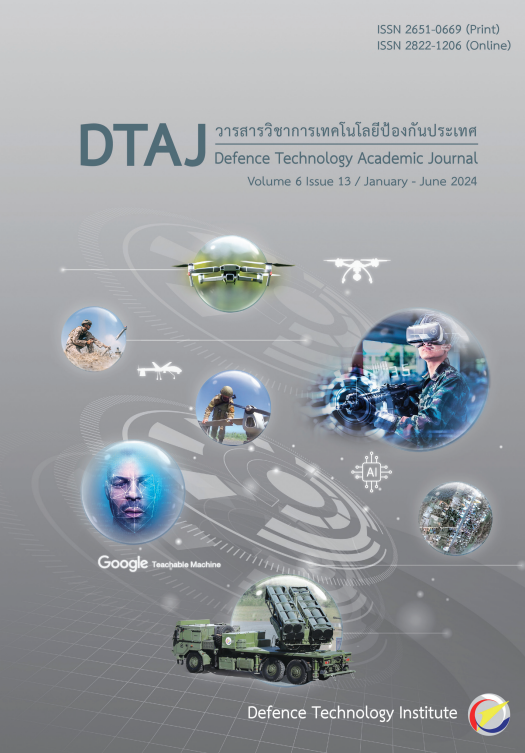Optimum Design of Electric X-Kamikaze Drone in Conceptual Design Phase using Metaheuristic
Main Article Content
Abstract
This research presents the optimization of the concept design of an electrically powered X-wing kamikaze drone using metaheuristics. The objective function consists of finding the minimum of aircraft weight and maximum of endurance taking into account of the flight mission and flight stability requirement. Vortex lattice method (VLM) is used to calculate the aerodynamics and flight stability, and the blade element momentum theory (BEMT) method is used for the analysis the propeller. Multi-objective metaheuristic with new concept of parameter adaptation (MMIPDE) is used as an optimizer. Three optimal design results were selected from the pareto front. Battery capacity directly affects both objective functions. Another design variable of the aircraft will change up to weight. The optimum values from the aircraft design will be taken into consideration in the next phase.
Downloads
Article Details

This work is licensed under a Creative Commons Attribution-NonCommercial-NoDerivatives 4.0 International License.
Journal of TCI is licensed under a Creative Commons Attribution-NonCommercial-NoDerivatives 4.0 International (CC BY-NC-ND 4.0) licence, unless otherwise stated. Please read our Policies page for more information...
References
Wikipedia. “IAI Harop.” EN.WIKIPEDIA.org. https://en.wikipedia.org/wiki/IAI_Harop (accessed Apr. 17, 2024).
AeroVironment. “SWITCHBLADE® 300 BLOCK 20.” AVINC.com. https://www.avinc.com/ lms/switchblade (accessed Apr. 17, 2024).
Wikipedia. “ZALA Lancet.” EN.WIKIPEDIA. org. https://en.wikipedia.org/wiki/ZALA_ Lancet (accessed Apr. 17, 2024).
M. H. Sadraey, Aircraft Design: A Systems Engineering Approach, Hoboken, NJ, USA: Wiley, 2012.
R. Storn and K. Price, “Differential Evolution - A Simple and Efficient Heuristic for Global Optimization over Continuous Spaces,” J. Glob. Optim., vol. 11, no. 4, pp. 341 - 359, 1997, doi: 10.1023/A:1008202821328.
J. Kennedy and R. Eberhart, “Particle Swarm Optimization,” ICNN’95 - Int. Conf. Neural Netw., Perth, WA, Australia, 1995, pp. 1942 - 1948, doi:10.1109/ICNN.1995.488968.
S. Mirjalili, P. Jangir, and S. Saremi, “Multi-objective Ant Lion Optimizer: A Multi-objective Optimization Algorithm for Solving Engineering Problems,” Appl. Intell., vol. 46, no. 1, pp. 79 - 95, 2017.
M. A. E. Aziz, A. A. Ewees, A. E. Hassanien, M. Mudhsh, and S. Xiong, “Multi-objective Whale Optimization Algorithm for Multilevel Thresholding Segmentation,” in Advances in Soft Computing and Machine Learning in Image Processing, A. E. Hassanien and D. A. Oliva, Eds., Cham, Switzerland: Springer, 2018, pp. 23 - 39.
J. Zhang and A. C. Sanderson, “JADE: Adaptive Differential Evolution with Optional External Archive,” IEEE Trans. Evol. Comput., vol. 13, no. 5, pp. 945–958, 2009.
S. Wang, Y. Li, and H. Yang, “Self adaptive Mutation Differential Evolution Algorithm based on Particle Swarm Optimization,” Appl. Soft Comput., vol. 81, p. 105496, 2019.
K. Wansasueb, N. Pholdee, N. Panagant, and S. Bureerat, “Multiobjective Meta heuristic with Iterative Parameter Distribution Estimation for Aeroelastic Design of an Aircraft Wing,” Eng. Comput., vol. 38, pp. 695 - 713, 2022.
K. Budziak, Aerodynamic Analysis with Athena Vortex Lattice (AVL). Hamburg, Germany: Hamburg Aircraft Design and Systems Group (AERO), Department of Automotive and Aeronautical Engineering, Hamburg University of Applied Sciences, 2015. [Online]. Available: https://nbn-resolving. org/urn:nbn:de:gbv:18302-aero2015- 09-20.015
R. A. McDonald and J. R. Gloudemans, “Open Vehicle Sketch Pad: An Open Source Parametric Geometry and Analysis Tool for Conceptual Aircraft Design,” in 2022 AIAA SCITECH Forum, 2022, doi: 10.2514/6.2022- 0004.
Cotri. “Blade Element Momentum Theory: Developed during My Bachelor Thesis in Aerospace Engineering.” GITHUB.com. https://github.com/cotri/BEMT (accessed Apr. 17, 2024).


